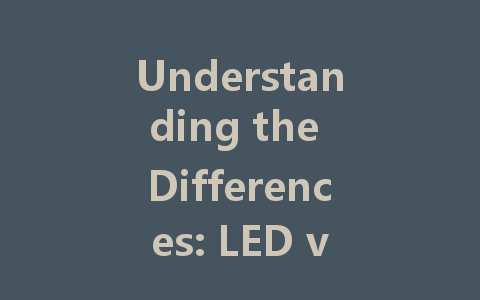
In today’s tech-savvy world, we often find ourselves surrounded by screens of various types. Whether it’s our smartphones, laptops, TVs, or even monitors, these devices all use different technologies to display images and videos. Among the most common types of screens are LED and LCD. While many people use these terms interchangeably, they are, in fact, different technologies. In this article, we’ll delve into the distinctions between LED and LCD screens to help you make informed choices when purchasing or upgrading your electronic devices.
What is LCD?
LCD stands for Liquid Crystal Display. This technology has been around for several decades and has become a standard for monitors and televisions. An LCD screen consists of a liquid crystal solution sandwiched between two layers of glass or plastic. The crystals can manipulate light, which allows for the creation of images.
How LCD Works
The LCD technology relies on a backlight, typically made from fluorescent bulbs or LEDs, to illuminate the screen. When you turn on an LCD screen, the backlight emits light that passes through the liquid crystals. These crystals change orientation depending on the electrical signals they receive, which allows them to block or allow the light to pass through—this creates the images you see on the screen.
What is LED?
LED stands for Light Emitting Diode. While it sounds similar to LCD, LED refers specifically to the type of backlighting used in screens. In essence, an LED screen is actually a type of LCD screen that uses LEDs for backlighting instead of traditional fluorescent lamps.
How LED Works
An LED screen utilizes a matrix of tiny light-emitting diodes to produce vivid colors and bright images. The LEDs can be arranged either as edge-lit (where the lights are placed along the edges of the screen) or full-array (where the lights are distributed evenly behind the entire screen). This technology offers better energy efficiency and is capable of producing deeper blacks and more vibrant colors due to enhanced contrast ratios.
Key Differences Between LED and LCD Screens
Color and Brightness
One major difference between LED and traditional LCD screens is the quality of color and brightness. LED technology tends to offer superior color reproduction and higher brightness levels. Because LEDs can be individually adjusted, they provide better black levels, leading to more contrast in images.
Energy Efficiency
LED screens consume less energy than traditional LCD screens. The use of LEDs for backlighting means they require less power, making them a more environmentally friendly option and potentially reducing your electricity bills over time.
Thinness and Design
LED screens are often thinner and lighter than LCD screens. The compact design allows for sleeker televisions and monitors, which can be advantageous for modern home aesthetics or workspace setups.
Lifespan
Generally, LED screens have a longer lifespan compared to traditional LCDs. This is partly due to the reduced heat output of LEDs compared to fluorescent backlights, which can degrade over time and contribute fewer issues with screen burn-in or other failures.
Advantages and Disadvantages
LED Screen Advantages
LCD Screen Advantages
Disadvantages
Applications of Each Technology
Where LED Screens Shine
LED technology is often preferred in high-end televisions and gaming monitors, where color accuracy and response time are critical. They have also gained popularity for outdoor screens and large-scale advertisements due to their high brightness levels and vibrant colors.
Typical Uses for LCD Screens
LCD screens, on the other hand, are still widely used in older monitors and budget devices. They can be found in a variety of applications, from computer monitors to projectors, though they are gradually being phased out in favor of LED and OLED technologies.
Conclusion
In summary, while LED and LCD screens might sound similar, they represent different technologies with distinct advantages and drawbacks. Understanding these differences can help you make better purchasing decisions—ensuring that you choose a screen that fits your needs, whether you’re gaming, working, or simply watching movies. If you’re looking for superior brightness, color, and energy efficiency, an LED screen is likely your best bet. However, if budget is your main concern and your usage is more basic, a traditional LCD screen might conveniently serve you well.
By grasping these concepts, you can navigate the world of display technology with confidence.